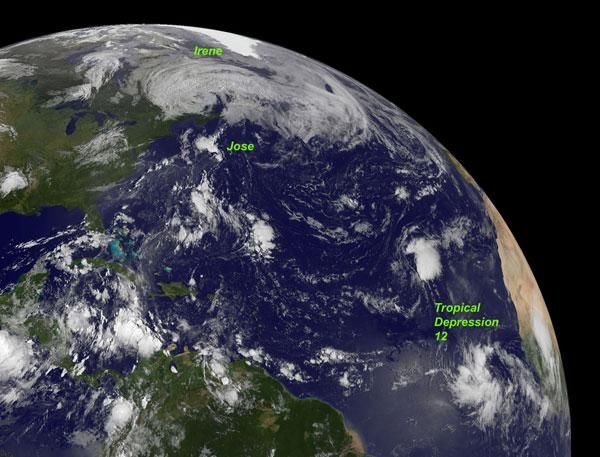
Could Katia Threaten the East Coast?

It was quite a weekend as Hurricane Irene tracked along the Atlantic Seaboard bringing torrential rains and roaring winds from the North Carolina coastline northward into western New England and causing widespread destruction with reports of at least 40 fatalities.
It appears that the region that received the greatest damage from Irene was the state of Vermont which suffered extensive and disastrous flash flooding. It was, in fact, the worst flooding in the Green Mountain State since the Great Flood of November 1927. First estimates for the United States suggest as much as $7 billion in damages.
A land-falling tropical hurricane for the Northeast is rather unusual, but is a meteorological phenomenon not totally unknown in that part of the country. Going back to 1960, there have been five hurricanes that have made their mark here: Donna (September 12-13, 1960), Belle (August 10, 1976), Gloria (September 27-28, 1985), Bob (August 19-20, 1991) and of course, Irene this past weekend. That averages out to one hurricane visit about every 10 years. In fact, there was one hurricane for each decade from the 1960s to the 1990s.
Since Bob's arrival in 1991 there hadn't been a visit from a tropical cyclone, so according to the law of averages it seems that the Northeast was long overdue.
Will Katia be a threat?
So when might the next hurricane threaten the Northeast? One might think in the aftermath of Irene, the next threat might not come for quite a few years. But in the coming days, those living along the Eastern Seaboard will be keeping a very close eye on another tropical troublemaker now located several hundred miles to the southwest of the Cape Verde Islands. [What U.S. Cities Are Most Vulnerable to a Hurricane?]
Tropical Storm Katia (pronounced "Kot-tia") is the 11th named storm in what is becoming a rather active season for Atlantic tropical cyclones. And yet, so far, Irene is the only tropical cyclone to attain hurricane status with sustained winds blowing in excess of 74 mph (119 kph).
Sign up for the Live Science daily newsletter now
Get the world’s most fascinating discoveries delivered straight to your inbox.
But Katia may change that: By Friday, and possibly as soon as Thursday, Katia is expected to become the season's second hurricane. And during the upcoming Labor Day weekend, she could become a major hurricane, sporting winds in excess of 115 mph (185 kph).
Beware those Cape Verde storms
Katia could evolve into a Cape Verde hurricane, which are usually the largest and most intense type of hurricane, chiefly because they develop over a large expanse of warm open ocean before encountering land. In fact, the five largest Atlantic tropical cyclones on record have been Cape Verde-type hurricanes.
The reason that Katia will probably garner close scrutiny from forecasters along the East Coast is that medium- and long-range computer outlooks suggest that the storm will slowly move on a westward trajectory, a track chiefly influenced by a ridge of subtropical high pressure over the eastern Atlantic. Katia should travel along the western boundary of the high pressure and is currently forecast to pass to the north of the Antilles during the upcoming weekend. It then is forecast to curve to the north and west. Just how quickly the storm makes the turn will ultimately determine whether it curves out to sea or whether it poses a threat to the East Coast. [Storm Targets: Where the Hurricanes Hit ]
As of this writing, the first scenario appears more likely, but we're still at least 8 to 10 days before Katia could reach a position relative to the United States where it might pose some kind of threat.
Double trouble
For those living in the Northeast, the odds of seeing another hurricane so soon after Irene's visit are rather long, but there is a notable precedent.
Long-time hurricane watchers might recall the year 1954, when Hurricane Carol swept rapidly north-northeast across eastern Long Island and through central New England on Aug. 31. Then, just 11 days later, Hurricane Edna, moving on a northeast course, impacted Cape Cod and downeast Maine.
In his autobiography, "In Joy Still Felt" (Doubleday & Co. 1980), legendary science writer, Isaac Asimov wrote about how these two hurricanes affected his hometown of Newton, Mass. On Aug. 31, for the arrival of Hurricane Carol he wrote:
"... no one was prepared, and if they had been, it would have made very little difference. Down went the trees, taking the power lines with them, and our electricity went off at noon. The loss of power was exciting at first, simply because it was so different. However, we lived in an all-electric house and without power, there were no lights, no cooking facilities, and no hot water and the power stayed off for five days!"
Six days later, Hurricane Edna arrived. Asimov observed:
"There was less wind this time, but more rain, and at 4:15 p.m., off went the power again. It was much harder to take this time (like being reinducted into the Army), and we spent a sixth night with candles. It had been off only 20 hours this time."
Closing the book on Irene
A final note on Irene: When an athlete ends up having a great career in his particular sport, what usually will follow is having his number retired. For tropical cyclones, there are six lists of names for tropical storms and hurricanes that repeat every six years. However, if there is an unusually large or damaging hurricane, the name is retired by the World Meteorological Organization (WMO).
The name "Irene" made its first appearance in 1981, but in the wake of what happened this past weekend, the name Irene could be retired by the WMO.
But that wouldn't happen for months or years. Now it's time focus attention on "Katia."












